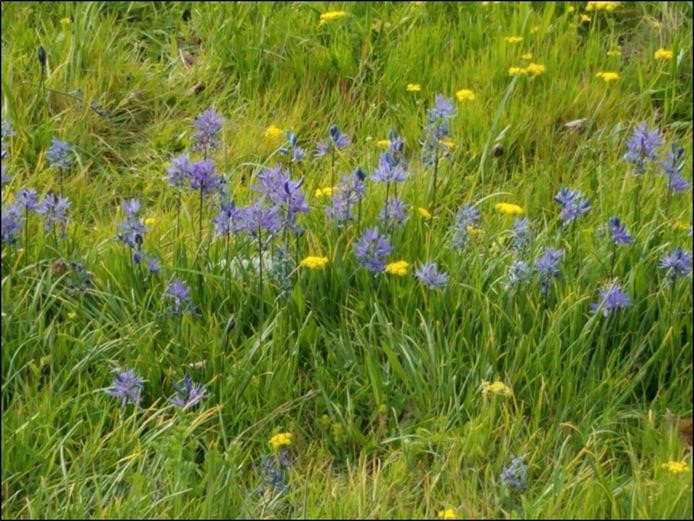
Iconic Delicacy of Sequim Prairies
| Common camas (Camassia quamash) was and continues to be one of the most important food sources for many indigenous peoples in western North America. One of the only sources of carbohydrates in the Pacific Northwest, small camas bulbs were harvested in thousands of pounds, dried in ovens and stored for winter use.
The bulb of this wild native lily is uprooted when in full bloom, where it forms spectacular displays in wetlands, grasslands, and oak savannahs in the Pacific Northwest. Camas fields were once widespread, but due to the increasing amount of oak savannahs and wetlands being converted for agriculture, housing, and development; suitable habitat is declining. In March, the River Center began hosting a speaker series, “Prairies and People of the Olympic Peninsula.” Jamestown S’Klallam tribal member Mackenzie Grinnell, Traditional Foods and Culture Program manager discussed prairies as a cultural ecosystem. He also noted a common misconception that most Native Americans were hunter-gatherers. After acknowledging that his ancestors did, in fact hunt and gather food from an abundance of sources, he pointed out that they were also farmers. The fields where the camas bulbs were harvested from, were burned periodically and carefully tended to in order to increase productivity. Plant densities were found to increase following fire and these sites were cleverly maintained. When Euro American colonization removed native peoples from their land and onto reservations, the presence of these cultural ecosystems shrank dramatically. Camas fields are now less common, but not abandoned. Native Americans continue to carefully collect bulbs in areas where wild camas still grows. Grinnell initiated a project in 2019 in a field east of the River Center to reestablish a working prairie of camas and other traditional plants. Want to learn more about Jamestown S’Klallam Tribe’s prehistoric connection with the Sequim Prairie? Join us on Wed. July 22nd at 4pm as we continue the “Prairies and People of the Olympic Peninsula” speaker series on a virtual platform! David Brownell, JSKT Tribal Historic Officer presents, “Archaeology of Sequim Prairies.” Click here to register and we will send you a link. PS: You could even try planting common camas in your own yard! Northwest Meadowscapes is now open to pre-order and reserve common camas bulbs being shipped out this fall! Click here if you want order and transform some of your lawn into a wildflower meadow. “These can be planted directly into newly seeded or mature wildflower meadows, or even planted directly into lawns!” – Northwest Meadowscapes seed farm |

